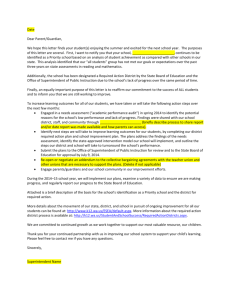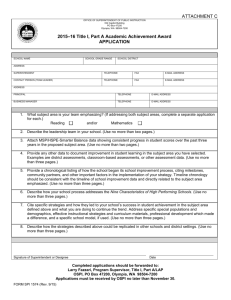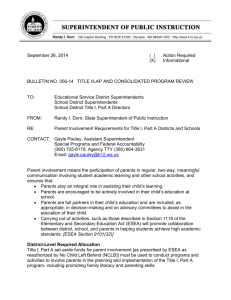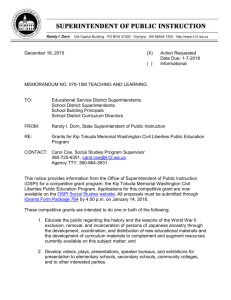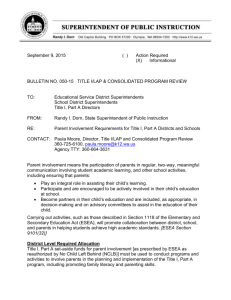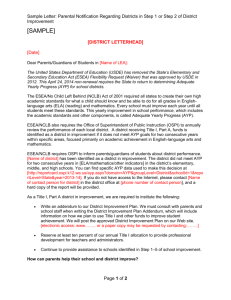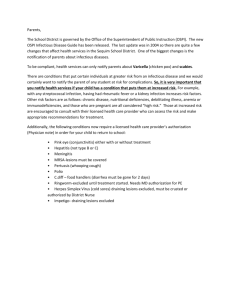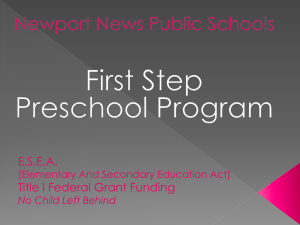Key Title I, Part A Parental Notice Requirements
advertisement
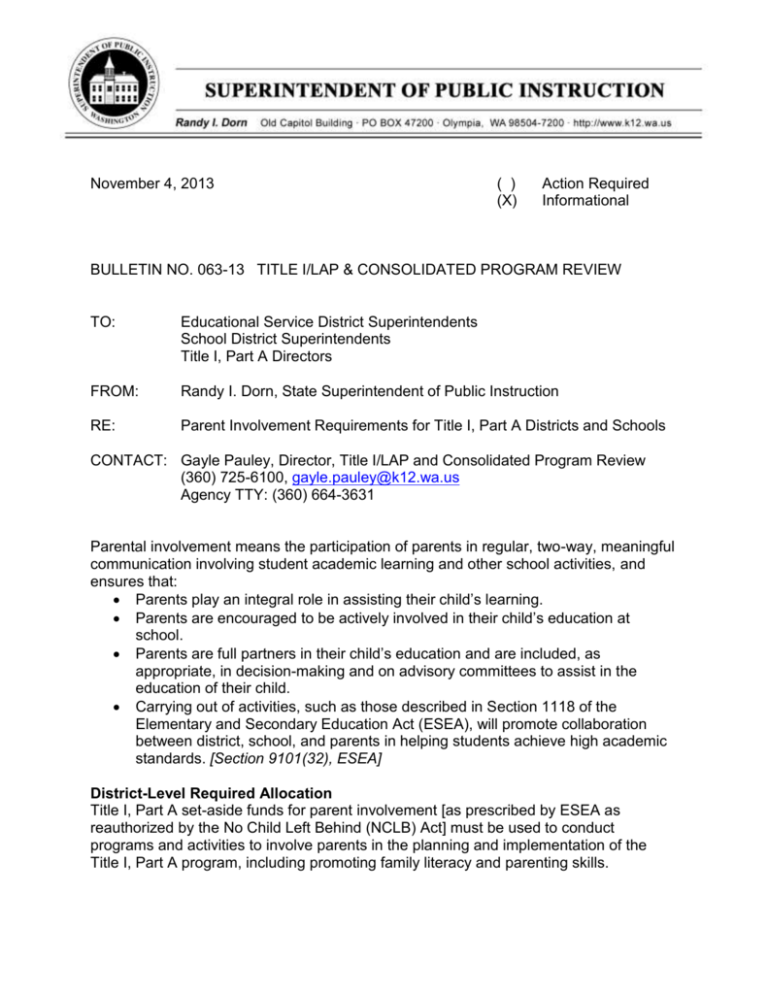
November 4, 2013 ( ) (X) Action Required Informational BULLETIN NO. 063-13 TITLE I/LAP & CONSOLIDATED PROGRAM REVIEW TO: Educational Service District Superintendents School District Superintendents Title I, Part A Directors FROM: Randy I. Dorn, State Superintendent of Public Instruction RE: Parent Involvement Requirements for Title I, Part A Districts and Schools CONTACT: Gayle Pauley, Director, Title I/LAP and Consolidated Program Review (360) 725-6100, gayle.pauley@k12.wa.us Agency TTY: (360) 664-3631 Parental involvement means the participation of parents in regular, two-way, meaningful communication involving student academic learning and other school activities, and ensures that: Parents play an integral role in assisting their child’s learning. Parents are encouraged to be actively involved in their child’s education at school. Parents are full partners in their child’s education and are included, as appropriate, in decision-making and on advisory committees to assist in the education of their child. Carrying out of activities, such as those described in Section 1118 of the Elementary and Secondary Education Act (ESEA), will promote collaboration between district, school, and parents in helping students achieve high academic standards. [Section 9101(32), ESEA] District-Level Required Allocation Title I, Part A set-aside funds for parent involvement [as prescribed by ESEA as reauthorized by the No Child Left Behind (NCLB) Act] must be used to conduct programs and activities to involve parents in the planning and implementation of the Title I, Part A program, including promoting family literacy and parenting skills. BULLETIN NO. 063-13 TI/LAP/CPR Page 2 November 4, 2013 Parents of children receiving Title I, Part A services must be involved in the development of the district parent involvement policy. The policy must include how decisions regarding set-aside funds are allotted for parental involvement activities and how parents will be included in the annual evaluation of the policy. For districts receiving an allocation of $500,000 or greater, the district must set-aside one percent of their district’s allocation. Not less than 95 percent of the one percent must be distributed to Title I, Part A schools for the purpose of parent-related activities. The school staff and parents may voluntarily decide that some or the entire amount of the set-aside be administered by the district. A district receiving less than $500,000 is not required to set aside funds for parent involvement. However, the district is still required to provide and promote parent activities and involvement opportunities. [ESEA Title I, Part A Section 1118(a)] District and School (Building) Level Written Policy Requirements Each district and school that receives Title I, Part A funds must: Develop a written parent involvement policy. Notify parents of the policy in an understandable and uniform format and to the extent practicable, provided in a language the parents can understand. Make the policy available to the local community and update periodically to meet the changing needs of parents and the school. If the district or school has a parental involvement policy that applies to all parents, the district or school may amend the policy to meet Title I, Part A parent involvement requirements. If the policy under ESEA Title I, Part A Section 1112 (Local Educational Agency Plans) is not satisfactory to the parents of Title I, Part A students, districts and schools must submit any parent comments with the policy when the school or district submits the policy to the state. [ESEA Title I, Part A Section 1118(b)] Attachment A provides district and school side-by-side required policy components. District and School Requirements and Responsibilities for Building Capacity In carrying out Title I, Part A parent involvement requirements, districts and schools, to the extent practicable, must provide full opportunities for the participation of parents with limited English proficiency, parents with disabilities, and parents of migratory children. Providing information and school reports required under Section 1111 in a format and, to the extent practicable, in a language the parents understand, must be included in these opportunities. 2 BULLETIN NO. 063-13 TI/LAP/CPR Page 3 November 4, 2013 Additionally, to ensure effective involvement of parents and to support a partnership among the school, parents, and the community, each district and school assisted by Title I, Part A funds must: 1. Provide assistance to parents of children served by the school or district, as appropriate, in understanding topics such as: a. The state’s academic content standards and state academic achievement standards. b. State and local assessments. c. The requirements of Title I, Part A. d. How to monitor a child’s progress and work with educators to improve the achievement of their children. 2. Provide materials and training to help parents to work with their children to improve their achievement, such as literacy training and using technology, as appropriate, to foster parent involvement. 3. Educate teachers, pupil services personnel, principals, and other staff, with the assistance of parents, in the value and utility of contributions of parents. Topics that need to be addressed include: how to reach out to, communicate with, and work with parents as equal partners; how to implement and coordinate parent programs; and how to build ties between parents and the school. 4. Coordinate and integrate, to the extent feasible and appropriate, parent involvement programs and activities with Head Start, the Home Instruction Programs for Preschool Youngsters, the Parents as Teachers Program, public preschool, and other programs. Conduct activities, such as parent resource centers, that encourage and support parents in more fully participating in the education of their children. 5. Ensure that information related to school and parent programs, meetings, and other activities is sent to the parents of participating children in a format and to the extent practicable, in a language the parents can understand. 6. Provide reasonable support for parent involvement activities as parents may request. [ESEA Title I, Part A Section 1118(e)] Key Title I, Part A Parental Notice Requirements As part of the Title I, Part A provisions to support the parental involvement requirements, each year districts and schools receiving Title I, Part A funds must provide certain statutory and regulatory requirements for notice or information to parents and students participating in Title I, Part A programs. Attachment B contains a list of the key Title I, Part A required parental notifications. 3 BULLETIN NO. 063-13 TI/LAP/CPR Page 4 November 4, 2013 Federal Programs Citizen Complaint Procedures Districts must disseminate free of charge to parents of students, and to appropriate private school officials or representatives, adequate information about the Office of Superintendent of Public Instruction’s (OSPI) written complaint procedures for resolving issues of violation(s) of a federal statute or regulation that applies to Title I, Part A programs. [Chapter 392-168 WAC Special Services Programs-Citizen Complaint Procedures for Certain Categorical Federal Programs]. Attachment C contains Federal Programs Citizen Complaint Procedures. If you have any questions regarding this bulletin or attachments, please contact the Title I/LAP and Consolidated Program Review office at (360) 725-6100 or email gayle.pauley@k12.wa.us. The agency TTY number is (360) 664-3631. This bulletin is also available on OSPI’s website at: http://www.k12.wa.us/BulletinsMemos/bulletins2013.aspx. K–12 EDUCATION Alan Burke, Ed.D. Deputy Superintendent SPECIAL PROGRAMS AND FEDERAL ACCOUNTABILITY Gil Mendoza, Ed.D. Assistant Superintendent Gayle Pauley, Director Title I/LAP and CPR RD:gp:jc Attachment A: District and School Side-by-Side Required Policy Components Attachment B: Key Title I, Part A Parental Notice Requirements Attachment C: Federal Programs Citizen Complaint Procedures OSPI provides equal access to all programs and services without discrimination based on sex, race, creed, religion, color, national origin, age, honorably discharged veteran or military status, sexual orientation including gender expression or identity, the presence of any sensory, mental, or physical disability, or the use of a trained dog guide or service animal by a person with a disability. Questions and complaints of alleged discrimination should be directed to the Equity and Civil Rights Director at (360) 725-6162 or P.O. Box 47200 Olympia, WA 98504-7200. 4 ATTACHMENT A District and School (Building) Side-by-Side Required Policy Components District Parent Involvement Policy Each Title I, Part A served district must: Develop jointly with, agree on with, and distribute to parents of Title I, Part A served students a written parent involvement policy that must be incorporated into the district’s policy developed under Section 1112. Establish the district’s expectation for parent involvement. Each Title I, Part A district will: A. Involve parents in: o The joint development of the policy under Section 1112. o The process of school review and improvement under Section 1116. School Parent Involvement Policy Each Title I, Part A served school in a district must: Develop jointly with, agree on with, and distribute to parents of participating students a written parent involvement policy that describes the means for carrying out the policy requirements. Each Title I, Part A school will: A. Convene an annual meeting, at a convenient time, to which all parents of participating children must be invited and encouraged to attend to inform parents of their school’s participation in Title I, Part A, the requirements of the program, and the right of the parents to be involved. B. Provide the coordination, technical assistance, and other support necessary to assist participating schools in the planning and implementing effective parent involvement activities to improve student academic achievement and school performance. B. Offer a flexible number of meetings, such as in the morning or in the evening. Funds may be used to provide transportation, child care, or home visits, as the services relate to parent involvement. C. Build the schools’ and parents’ capacity for strong parental involvement as explained in ESEA Title I, Part A Section 1118(e). C. Involve parents in an organized, ongoing, and timely way, in the planning, review, and improvement of Title I, Part A programs, including the planning, review, and improvement of the school parental involvement policy and the joint development of the schoolwide plan. If the school already has a process in place, it may use that process, if it includes an adequate representation of parents of participating children. 1 ATTACHMENT A District Parent Involvement Policy D. Coordinate and integrate parental involvement strategies with parent involvement strategies under other programs, such as: o Head Start o Parents as Teachers o Home Instruction Program for Preschool Youngsters o State-run preschools E. Conduct, with the involvement of parents, an annual evaluation of the content and effectiveness of the parental involvement policy in improving the academic quality of the school served including: o Identifying barriers to greater participation of parents in Title I, Part Arelated activities, with particular attention to parents who are economically disadvantaged or disabled, and parents who have limited English proficiency, limited literacy, or any racial or ethnic minority background. Revise the policy where necessary to address ways to overcome identified barriers. School Parent Involvement Policy D. Provide parents of participating children: o Timely information about Title I, Part A programs. o A description and explanation of the curriculum in use at the school, the forms of academic assessment used to measure student progress, and the proficiency levels students are expected to meet. o If requested by parents, opportunities for regular meetings to formulate suggestions and to participate, as appropriate, in decisions relating to the education of their children, and to respond to any such suggestions as soon as practicably possibly. If the schoolwide plan is unsatisfactory to the parents of participating children, submit parent comments when the school makes the plan available to the district. E. As a component of the school parent involvement policy development, each school served shall jointly develop with parents of served children a schoolparent compact that outlines how: o Parents, the entire staff, and students will share the responsibility for improved student academic achievement and the means by which the school and parents will build and develop a partnership to help children achieve the state’s high standards. o The school will provide high-quality curriculum and instruction in a supportive and effective learning environment that enables the children served to meet the state’s academic achievement standards. 2 ATTACHMENT A District Parent Involvement Policy School Parent Involvement Policy o Each parent will be responsible for supporting their children’s learning; and participating, as appropriate, in decisions relating to the education of their children and positive extracurricular time. The compact will also address the importance of communication between teachers and parents on an on-going basis through, at a minimum: o Parent-teacher conference in elementary schools, at least annually, during which the compact must be discussed as it relates to the individual child’s achievement. o Frequent reports to parents on their children’s progress. o Reasonable access to staff, opportunities to volunteer and participate in their child’s class, and observation of classroom activities. F. Involve parents in the activities of the schools served under this part. [ESEA Section 1118(a)(2)] 3 ATTACHMENT B Key Title I, Part A Parental Notice Requirements This table includes key Title I, Part A statutory and regulatory requirements for notice or information given or disseminated to parents of students participating in Title I, Part A programs. It is not intended to be an exhaustive list, and does not include consultation, collaboration, technical assistance, training, or other types of requirements. Except where otherwise indicated, the terms “districts” and “schools” refer to Local Educational Agencies (LEAs) with programs funded under Title I, Part A of ESEA. Key Title I, Part A When Parental Notice Requirements Annual report cards–OSPI and districts disseminate to parents, schools, and the public, an annual report card with aggregate information, including student achievement (disaggregated by category), graduation rates, performance of district, teacher qualifications, and other required information. [Section 1111(h)(1) and (2), ESEA]; NonRegulatory Guidance, B-5 (SEA) and C-7 (LEA) Individual student assessment reports– OSPI, in consultation with districts and schools, provide to parents, teachers, and principals of students in all schools individual student interpretive, descriptive, and diagnostic reports, which allow specific academic needs to be understood and addressed, and include information on the student’s achievement on academic assessments aligned with state academic achievement standards. [Section 1111(b)(3)(C)(xii), ESEA] Progress review–OSPI disseminates to parents, districts, schools, teachers and other staff, students, and the community the results of the state’s yearly progress review of each district and school, including progress in carrying out parental involvement responsibilities; districts disseminate to parents, teachers, principals, schools, and Annually As soon as practicable after the assessment is given. It is a shared responsibility between OSPI, districts, and schools. Annually, it is a shared responsibility between OSPI, districts, and schools. By Whom District School (Building) 1 ATTACHMENT B Key Title I, Part A When Parental Notice Requirements the community the results of the district’s yearly progress review of each school. [Section 1116(a)(1)(C), (c)(1)(B) and (c)(6), ESEA]; Non-Regulatory Guidance, B-7 (SEA) and C-20 (LEA) By Whom District School (Building) Schools identified as Reward, Priority, Focus, and/or Emerging–OSPI and districts notify parents of children enrolled in schools in the district that have been identified as a Reward, Priority, Focus, and/or Emerging schools. Reward schools are classified as either “highest performing schools” or “highprogress schools.” Priority schools are among the lowest five percent of the Title I, Part A schools in the state, based on achievement on statewide assessments in reading and math combined over the three years. Focus schools are among the lowest 10 percent of the Title I, Part A schools in the state. They have the consistently lowest performing subgroups on statewide assessments in reading and math (combined) over three years. Emerging schools include the next five percent of Title I, Part A schools from the bottom of the list used to identify Priority schools and the next 10 percent of Title I, Part A schools from the bottom of the list used to identify Focus schools. Promptly upon identification [ESEA Flexibility Waiver –Washington State] Written parental involvement policies– Districts notify parents of Title I, Part A children of district-level written parental involvement policy; schools notify parents and community of school’s written parental involvement policy. [Section 1118(a)(2) and Determined by LEA (Usually in fall) District policy School or building policy 2 ATTACHMENT B Key Title I, Part A When Parental Notice Requirements By Whom District School (Building) (b)(1), ESEA]; Non-Regulatory Guidance, C3 and C-4 (LEA), and D-1 (School) Written SEA (OSPI) complaint procedures–Districts disseminate free of charge to parents of students, and to appropriate private school officials or representatives, adequate information about OSPI’s written complaint procedures for resolving issues of violation(s) of a federal statute or regulation that applies to Title I, Part A programs. [Chapter 392-168 WAC Special Services Programs-Citizen Complaint Procedures for Certain Categorical Federal Programs] Parents’ right to know–teacher and paraprofessional qualifications–District and schools inform parents of Title I, Part A students that parents may request, and the district and schools then will provide, certain information on the professional qualifications of the student’s classroom teachers and paraprofessionals providing services to the child. [Section 1111(h)(6)(A), ESEA]; NonRegulatory Guidance, C-6 Parents’ right to know–non-highly qualified teachers–Schools provide to each individual parent timely notice that the parent’s child has been assigned, or taught for four or more consecutive weeks by, a teacher who is not highly qualified. [Section 1111(h)(6)(B)(ii), ESEA]; Non-Regulatory Guidance, D-3 Parents’ right to know–student achievement–Schools provide to each individual parent, information on the level of achievement of the parent’s child in each of the state academic assessments. [Section 1111(h)(6)(B)(i), ESEA]; Non-Regulatory On-going Annually, at beginning of school year Timely Usually determined by district. It is a shared responsibility 3 ATTACHMENT B Key Title I, Part A When Parental Notice Requirements Guidance D-10 NOTE: This requirement may be covered by OSPI’s individual student assessment report indicated above. Title I, Part A meeting–Schools (buildings) invite parents to an informational meeting to inform them about the school’s participation in Title I, Part A programs and explain the requirements and their right to be involved. [Section 1118(c)(1) and (2), ESEA]; NonRegulatory Guidance, D-5 Title I, Part A information–Schools (buildings) provide to parents of participating children specific information about Title I, Part A programs, and opportunity to request regular meetings. [Section 1118(c)(4), ESEA]; Non-Regulatory Guidance, D-6 By Whom District School (Building) between the districts and schools. Annually On-going 4 ATTACHMENT C Federal Programs Citizen Complaint Procedures Chapter 392-168 WAC Complaints Against School Districts, Educational Service Districts (ESDs), or Subgrantees These complaint procedures apply to federal programs authorized under the Elementary and Secondary Education Act (ESEA), including Title I, Part A: Improving Academic Achievement of the Disadvantaged. Anyone Can File a Complaint A written complaint must be filed with the Office of Superintendent of Public Instruction (OSPI) and must include: 1. A statement that a school district, an ESD, or a subgrantee has violated a federal or state law or regulation that applies to a federal program authorized under the ESEA. 2. A description of what happened and why it violates a federal program requirement in state or federal law or regulation. 3. Name and address of the complainant. 4. Expected resolution. 5. Name and address of the school district, ESD, or subgrantee that is alleged to have violated the law or regulation. Investigation and Response by the District, ESD, or Subgrantee After receiving the complaint, OSPI will refer it to the educational entity for investigation. The school district, ESD, or subgrantee must designate an employee to investigate the complaint. The designated employee must respond in writing to OSPI with documentation of the investigation within 20 calendar days after receipt of the complaint. The response to OSPI should either deny the allegations in the complaint and the basis for the denial, or propose the reasonable corrective actions to correct the violation. OSPI Investigation and Response OSPI will provide the complainant a copy of the school district, ESD, or subgrantee’s response to the complaint. The complainant will then have an opportunity to submit additional information about the allegations in the complaint. OSPI will review all relevant information, and may conduct an on-site investigation. OSPI will make an independent determination as to whether the district, ESD, or subgrantee is in violation of any federal program requirement. OSPI will issue a written decision to the complainant, which will include findings of fact, conclusions, and reasonable corrective measures necessary to correct any violation. OSPI will issue this decision within 60 calendar days after receiving the complaint, unless exceptional circumstances of a particular complaint require additional time. All corrective actions must be instituted within 30 calendar days after OSPI’s decision. 1 ATTACHMENT C Note: The complainant and the educational entity involved (i.e., district, ESD, subgrantee) may agree, in writing, to waive the timelines provided in these rules. Waiver of the timelines must be communicated to OSPI within 10 calendar days. Complaints Against OSPI Anyone Can File a Complaint A written complaint must be filed with OSPI and must include: 1. A statement that OSPI has violated a federal or state law or regulation that applies to a federal program. 2. A description of what happened and why it violates a federal program requirement in state or federal law or regulation. 3. Name and address of the complainant. 4. Expected resolution. OSPI Investigation and Response After OSPI receives the complaint, OSPI will designate an employee to investigate the complaint. The investigation must start within 10 calendar days after OSPI receives the complaint. The designated employee will provide the State Superintendent with a written report of the results of the investigation within 60 calendar days after receiving the complaint. The State Superintendent must respond in writing to the complainant within 10 calendar days after receiving this report. The response will state that the allegations are denied and the basis for the denial, OR the reasonable corrective measures deemed necessary to correct any violation. Any corrective measures must be instituted within 30 calendar days from the date of this response. Note: The State Superintendent and the complainant may mutually agree to extend the time limits in these rules. If exceptional circumstances exist with respect to a particular complaint, the State Superintendent may unilaterally extend the timelines for cause upon written notice to the parties. Appeals If the complainant is not satisfied with OSPI’s response to a complaint, the complainant may file an appeal directly with the Secretary of the U.S. Department of Education at www.ed.gov. 2
